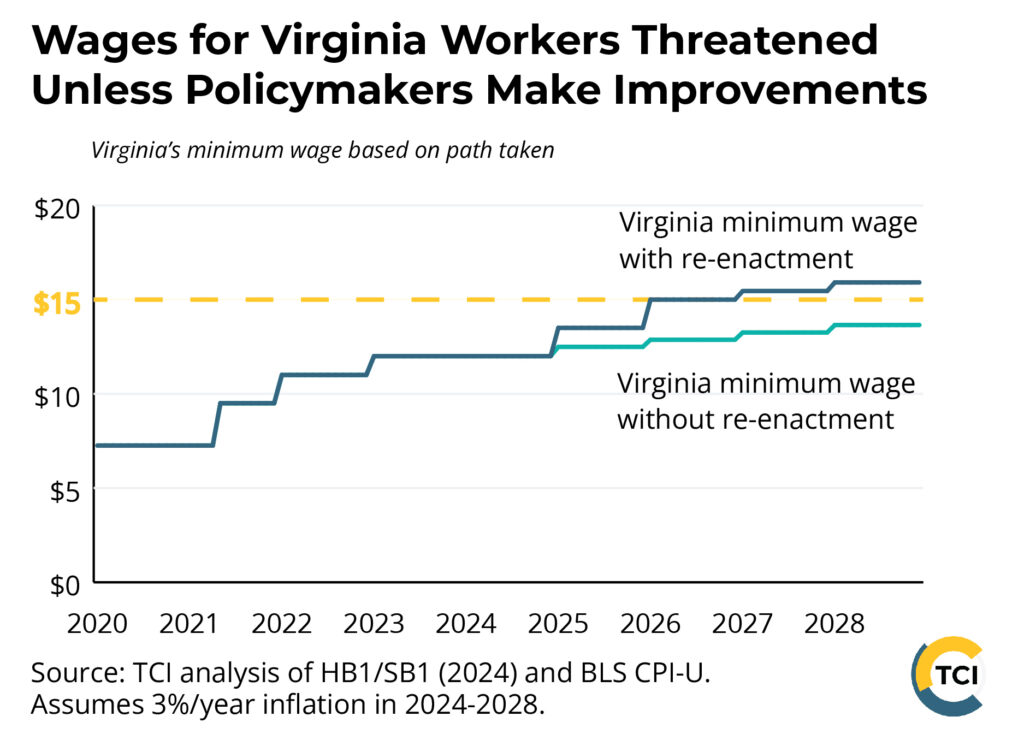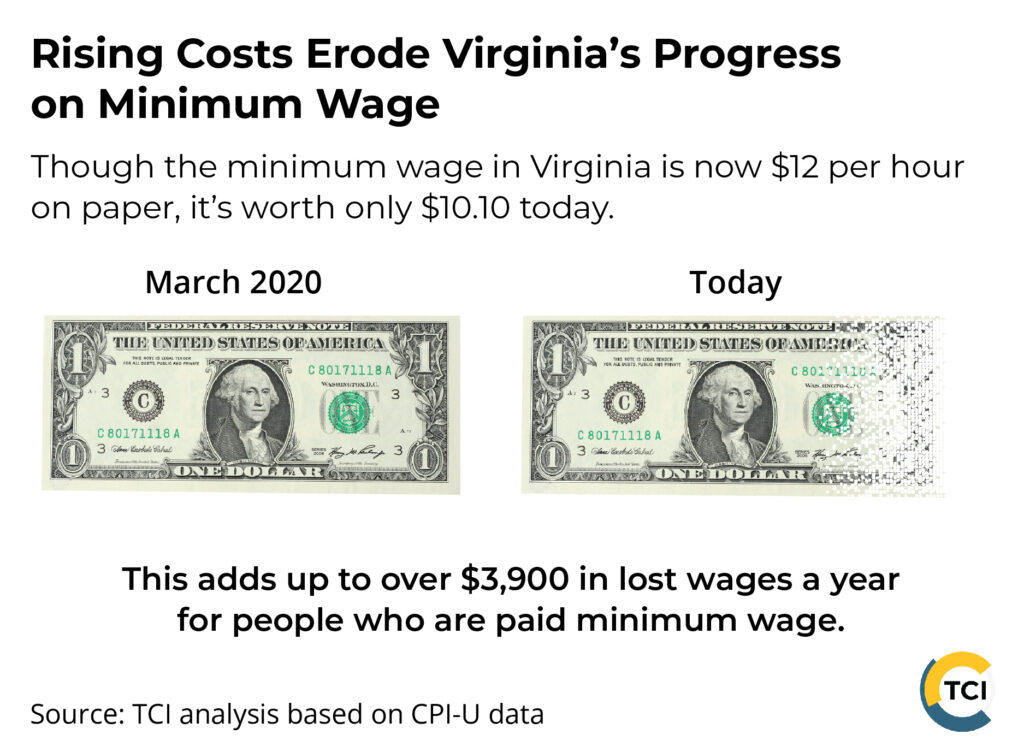January 16, 2024
$12 is Not Enough – Virginia Policymakers Must Act on the Minimum Wage
Everyone in Virginia working a full-time job should be paid enough to provide for their family. However, for too many this is not the case. Nearly two-thirds of Virginia families with incomes below the federal poverty threshold – just $25,820 for a family of three – have at least one adult who is working, yet they are paid too little to make ends meet. Even after the rapid inflation of the past 18 months and our progress in raising Virginia’s minimum wage from $7.25 to $12 an hour, 1 in every 8 Virginia workers is still paid less than $15 an hour. Virginia’s current minimum wage of $12 an hour is far below a living wage for even a single adult in Virginia, creating a low floor that limits the bargaining power of working Virginians. Virginia policymakers should raise the wages of working people in Virginia and help families across the commonwealth by raising Virginia’s minimum wage, closing loopholes that currently exclude many Black and Latino workers, and making sure Virginia’s wage laws are fairly enforced.

The evidence from Virginia and across the country shows that raising the minimum wage works to build opportunity. Today, Virginia has low unemployment rates and high rates of employment for the working-age population. And in states that have raised their minimum wages in the last 15 years, worker wealth grew faster than in states that remained stuck at the federal minimum wage, and this was particularly true for Black and Latino workers in states that charted a path to a $15 minimum wage.
Unexpected Inflation and Re-Enactment Clause Creates Need for Action
Unfortunately, the unexpectedly high levels of inflation mean that the 2020 minimum wage choices are far from enough. Under normal inflation conditions, prices would have been expected to rise about 7.7% between when Virginia’s minimum wage law passed in early 2020 and late 2023. Instead, prices have increased 19%. To have the same buying power today as policymakers could have reasonably expected when they passed the minimum wage law in 2020, Virginia’s minimum wage should already be $13.31. This erosion in the buying power of the minimum wage has particularly harmed Black and Latino working people. This is because working people of color in Virginia are more likely than white workers in Virginia to be stuck in low-wage occupations due to ongoing job discrimination, lack of educational opportunities, and other barriers that white people in Virginia are less likely to have faced.

To make matters worse, if policymakers don’t act this year, Virginia will stall on its path to the $15 minimum wage by 2026 that was mapped out by legislators in 2020. This is because the 2020 law had a “re-enactment” clause included, which means the path to $15 will not continue unless legislators act again. Instead, the minimum wage will remain at $12 an hour until January 2025, and then will only be adjusted for annual inflation, with no special adjustment for the unexpectedly high inflation since 2020.
Raising the Minimum Wage will Help Virginia Families and Communities as a Whole
Raising the minimum wage would help the very people and families in Virginia who have faced the greatest barriers. Continuing Virginia on the path to $15 an hour by 2026 will raise wages for about 611,000 working Virginians, most of whom work at least 35 hours a week. Nine out of every 10 workers who will benefit are over age 20, most are workers of color, and 6 out of every 10 are women. Annual income for year-round workers who would be impacted by the increase would rise by an average of about $1,300 in 2022 dollars. That’s money that working families with low incomes can use to pay the rent, make needed car repairs, and buy back-to-school supplies. And raising the wages of families with low incomes — who tend to spend most of their income in their own communities rather than on vacations abroad or being able to save for future generations — will help support more spending at local businesses.
“Raising the minimum wage would help the very people and families in Virginia who have faced the greatest barriers.“
Raising the minimum wage will also help lift poor working families above the poverty line, a change that will help children grow up in families with less stress and more stability. Over three-fifths of Virginia families with incomes below the poverty threshold have at least one adult in the household who is working. As a result, around 125,000 working adults live in Virginia households with incomes below the poverty threshold, which is just $25,820 for a family of three. Raising the wages of these working adults will benefit Virginia children as well as the working adults themselves. And Virginians who are Black or Latino continue to be more likely than white and Asian American Virginians to have incomes below the poverty line. This is not by chance – state policymakers have created and perpetuated historical inequities by not adequately funding schools in high-poverty communities, failing to invest in housing opportunities, and actively working to suppress organizing by working people. Raising the minimum wage will help to reverse this: while $12 an hour for a full-time, year-round worker is not enough to support a family of three at the poverty level, $15 an hour is enough to lift most working families with a full-time, year-round worker above the official poverty line. However, even with a $15-an-hour minimum wage, many families will still struggle to afford the basics due to the impact of inflation and the high cost of childcare and housing in many areas of Virginia, but every dollar makes a difference.
Well-meaning fears about job loss are misplaced
Recent studies of the effects of raising the minimum wage find little to no job losses and significant benefits for workers who are paid low wages, including higher wages, higher total incomes, and lower poverty rates. The effect of raising the minimum wage is one of the most heavily studied topics in economics, and most recent studies that use the highest-quality research designs have concluded that past increases in the minimum wage have had little to no effect on employment levels. While there may be some reduction in the number of hours worked, especially in the initial adjustment period, working people are better off because the wage increases more than offset any reduction in hours worked.
For example, in a January 2019 National Bureau of Economic Research working paper, Doruk Cengiz and co-authors studied 138 state-level changes in the minimum wage between 1979 and 2016 and found “the overall number of low-wage jobs remained essentially unchanged over five years following the increase.” Importantly, this study included increases in the minimum wage up to 55% of the state’s median wage and found no negative employment effects even up to those levels; assuming only modest 2.5% nominal median wage gains from 2022 to 2026, the proposed $15 minimum wage by 2026 will not exceed that threshold. And a 2016 meta-analysis of 37 published minimum wage studies found “no support for the proposition that the minimum wage has had an important effect on U.S. employment.”
Meaningful changes in the minimum wage have been done before in the southern United States without negative employment effects. Continuing Virginia on the path to $15 an hour by 2026 will benefit a significant share of working people in Virginia, yet it is not unprecedented in the share of workers who benefit. The 1967 extension of the Fair Labor and Standards Act (FLSA) to the agricultural, hotel, restaurant, and other sectors that were large employers in the south, and where Black workers represented over a third of the workforce, resulted in large gains in wages for Black workers without any negative effects on employment levels for either Black or white workers. One 2021 analysis estimated that the expansion of coverage in the federal minimum wage accounted for more than 20% of the reduction in wage and income penalties for Black families during the civil rights era.
Taking a step back, the narrow focus on the overall number of jobs or hours worked is a flawed way of measuring the impact of minimum wage increases, because what matters to low-wage working people is their total income throughout the year. Even those low-wage workers who may see a reduction in hours or even lose a job are likely to be financially better off with a higher minimum wage over the course of the year. That’s because frequent turnover in low-wage occupations means most low-wage workers already typically hold multiple jobs over the course of a year, and the higher wages will more than offset the reduction in hours for most impacted workers, resulting in an increase in total annual earnings.
The state minimum wage should lift families in all parts of the commonwealth
People across the commonwealth work hard and deserve to be paid a fair wage. Nowhere in Virginia is the current minimum wage sufficient to reasonably pay the bills of even a childless adult, and a higher universal wage floor will help lift families across the commonwealth. And despite some fears, research shows that doing so is unlikely to have significant negative job impacts. A recent study of the effect of raising the minimum wage in counties and other small areas where the new minimum wage is a high share of the overall typical (median) wage found positive impacts on wages, a reduction in household and child poverty rates, and no adverse effects on employment, weekly hours, or annual weeks worked. The same study also looked specifically at some of the groups of workers who are most impacted by raising the minimum wage (women, Black, and/or Hispanic workers) and found no adverse employment for any subgroup, even in these low-wage areas of the country.
There may be a need for a minimum wage that is higher than the statewide level in high-cost parts of Virginia. Along with setting a statewide wage floor of at least $15 an hour to make sure no working Virginian is left with below-poverty wages, state policymakers could consider providing cities and counties with the authority to set higher wage floors as appropriate for their localities.
Conclusion
In spite of barriers and challenges faced by Virginia families, people have historically and successfully been able to come together to make public policy work better for all of us. This includes Black and white families who came together to win state funding for a system of free public schools in 1870, the fight by Black students in the 1950s to make sure they had access to decent school buildings and textbooks, the successful work by Black, brown, and white families across the commonwealth to win broader access to health care through Medicaid expansion in the 2010s, and Virginia’s increase in the minimum wage in 2020. Coming together again to protect and advance Virginia’s minimum wage would be a step in the right direction for working families across the commonwealth, including those Black and Latino families who face the biggest barriers today.
